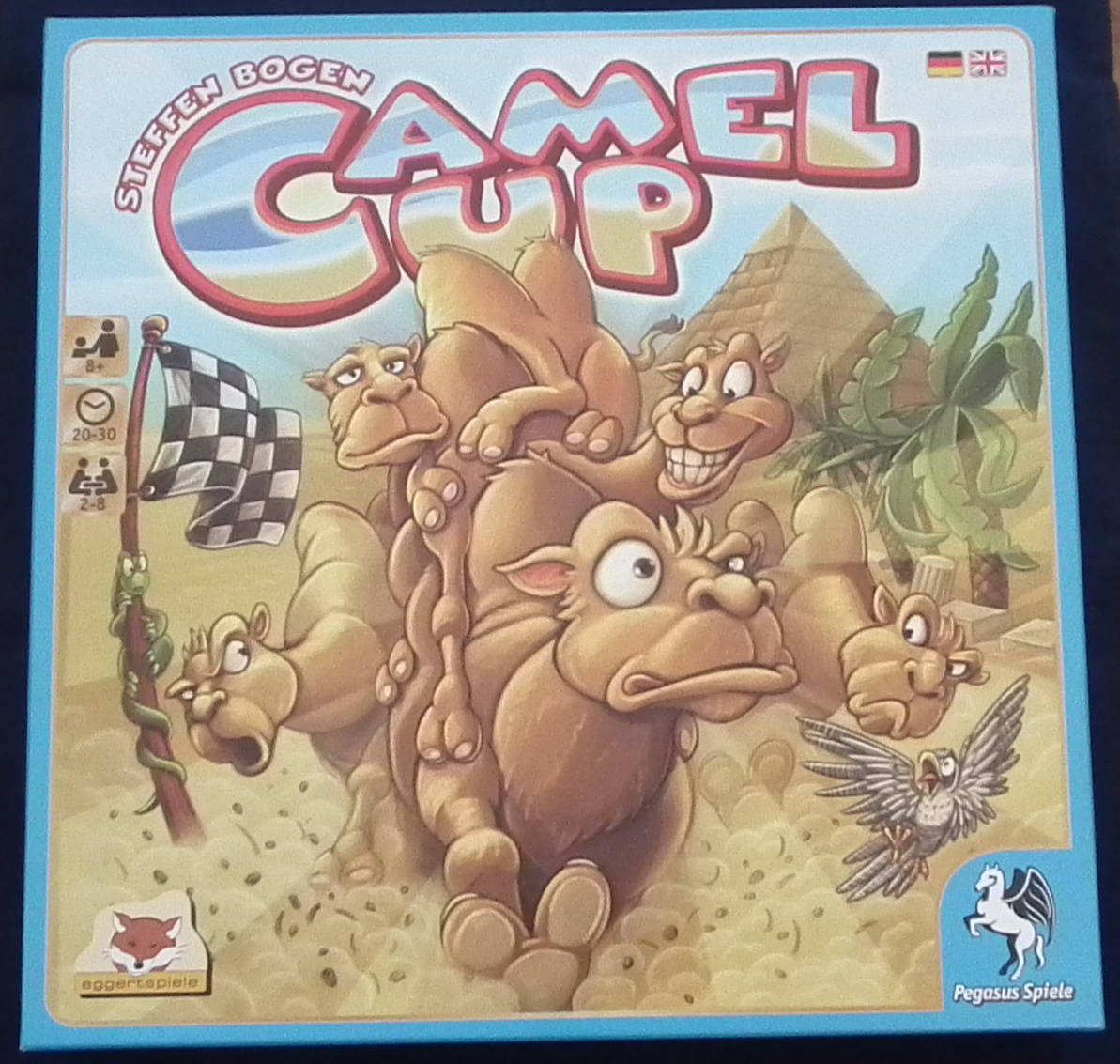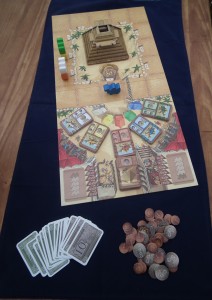Now I like to think of myself as an open minded guy; I’ve played board games based on moving barrels of rum (actually better than it sounds), panda pleasing (absolutely brilliant game) and even giant boobed versions of the Norse gods (Kanzume Goddess has a lot to answer for) but when someone presented this game to me at our gaming night, I must say I had my reservations. Within ten minutes however, I was sold, and here’s why.
Camel Up, winner of one of this year’s Spiel de Jahres, is a game where you, the punters, are betting on the results of a camel race around a pyramid. The race itself is split into legs and the race, with the legs being determined by all 5 dice being rolled (more on this later). Players can bet on who will win each leg AND on who they think will come first or last. Players lose money for making the wrong call, whilst quick and lucky gamblers reap the reward of insight/jamminess. The player with the most coins at the end of the game wins.
Gameplay is fairly straightforward. Players take one action a turn; these actions include betting on a leg winner, betting on the race winner, betting on the race loser, place/move an Oasis, and rolling a die.
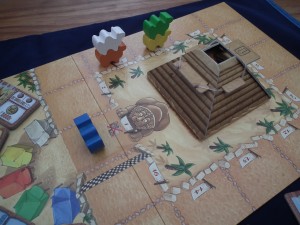
Rolling the die moves the camels around the track, with five different coloured dice for each of the camels. The quirky part of the game is the fact that no camel can share the same space on the race track; if a camel lands on an occupied space, they end up stacking on top of the poor blighter already there! Camels on top are considered ‘ahead’ of those underneath when determining leg and race winners. Furthermore, if a camel at the bottom of a stack ends up moving, all the camels in top of it move with it! This crazy system means no bets are sound until at least four or five dice have been rolled, as camels at the back can end up winning the race if the dice are favourable. This also makes Camel Up a great game for people who like to crunch numbers and perform statistical analysis in their head. For the rest of us, the hijinks present hilarious situations where the blue camel ends up going from first to last as he gets mounted by every other camel in the race like some humped harlot.
Betting on a leg means taking a chit for the camel you think will be in the lead at the end of a leg (a leg ends when all the dice have been rolled; if the race isn’t over, the dice go back in the pyramid, the leg bets pay out and a new leg starts). What I love here is the risk/reward mechanic presented by the leg bets. Each camel only has three betting chits you can take. If you take the first one and the matching camel is ahead at the end of the leg, you’ll make $5. If you took the second chit because the first was already taken, you’d only get $3; the third chit is only worth $2. So the game instantly creates this sense of tension as players sum up the risks of betting early against biding your time for more information. This is a wonderful way to build player engagement, sitting with fingers crossed as you will someone not to take the last chit for the camel you think will win.
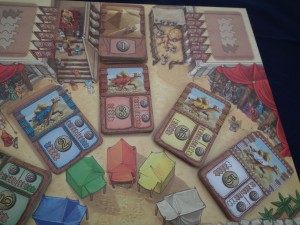
Race winner and loser bets work slightly differently. Each player will have five cards matching the five coloured camels. As an action. A player can place one of these card on the winner and loser sections of the board. At the end of the game, these cards are read out in the same order they were stacked in. If you guessed correctly and your card comes up first, you win $8 dollars. The second person to guess correctly only gets $5, third $3 and so one. Every wrong answer will lose that player $1. Again, this system ramps up the anxiety of the players who have to calculate the best time to pop their cards onto the stacks.
The Oases are the only way for the players to directly influence the race itself. Each players gets one to use, and as an action a player can place or remove and Oasis from a space on the board, or flip theirs over. If a camel lands on an Oasis, it will either move forward or back one space, depending on which way up the Oasis has been placed. Furthermore, if the camel goes back a space into more camels, it ends up at the BOTTOM of the stack; this again can rapidly alter the outcome of the race. In addition to screwing with the race the owner of the landed-on Oasis gets $1 for their shenanigans.
The effects of the dice and Oases together create situations where anything can happen. For your hardened eurogamer, the sheer randomness will leave you frothing at the (camel) bit as no sure strategy exists to winning. On the flip side, Camel Up makes no bones about what it is: it’s a game about gambling, and just like this expensive past time the best you can do is play the odds, and not cry when your ‘dead cert 3 – 1 on Albino Bob’ ends up with Bobby becoming the bottom of a four camel dogpile. Personally I love this about Camel Up, with the refreshing lack of misrepresentation. Camel Up doesn’t claim to be a strategic masterpiece, just a fun game where no-one, hardcore or casual gamer, is left out of their depth.
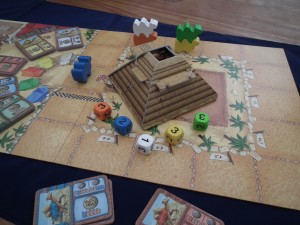
But will you be playing it in 6 months? Well, Camel Up is a great game, it supports up to 8 players and has a play time of around 45 minutes. This makes it ideal for larger play groups and that quick game whilst you wait for others to finish up, but I don’t think it will replace other greats like Carcassonne or Lords of Waterdeep. Don’t get me wrong, it’s good but I don’t think Camel Up will have the staying power of many other greats out there.
Lastly, the artwork is fantastic. Its cartoon stylings perfectly capture the light and amusing theme of the game itself, being engaging without becoming garish. Special mention has to go the pyramid dice shaker, possibly one of the best board game components I’ve ever seen! Unfortunately, build quality isn’t perfect. After only a couple of play throughs, several of the components are showing wear with the printed top layers peeling off the card stock.
So Camel Up is an engaging and inclusive game which is relatively simple and well presented, albeit a little delicate. I’m loving it now, but I don’t think it’ll stay in my top ten by next year.


